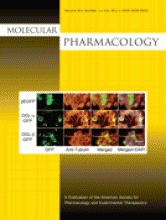Abstract
Abelson family kinases (AFKs; Abl1, Abl2) are non-receptor tyrosine kinases (NRTKs) implicated in cancer, but they also have important physiological roles that include regulating synaptic structure and function. Recent studies using Abl-deficient mice and the antileukemia drug STI571 [imatinib mesylate (Gleevec); Novartis], which potently and selectively blocks Abl kinase activity, implicate AFKs in regulating presynaptic neurotransmitter release in hippocampus and postsynaptic clustering of nicotinic acetylcholine receptors (nAChRs) in muscle. Here, we tested whether AFKs are relevant for regulating nAChRs and nAChR-mediated synapses on autonomic neurons. AFK immunoreactivity was detected in ciliary ganglion (CG) lysates and neurons, and STI571 application blocked endogenous Abl tyrosine kinase activity. With similar potency, STI571 specifically reduced whole-cell current responses generated by both nicotinic receptor subtypes present on CG neurons (α3*- and α7-nAChRs) and lowered the frequency and amplitude of α3*-nAChR-mediated excitatory postsynaptic currents. Quantal analysis indicated that the synaptic perturbations were postsynaptic in origin, and confocal imaging experiments revealed they were unaccompanied by changes in nAChR clustering or alignment with presynaptic terminals. The results indicate that in autonomic neurons, Abl kinase activity normally supports postsynaptic nAChR function to sustain nAChR-mediated neurotransmission. Such consequences contrast with the influence of Abl kinase activity on presynaptic function and synaptic structure in hippocampus and muscle, respectively, demonstrating a cell-specific mechanism of action. Finally, because STI571 potently inhibits Abl kinase activity, the autonomic dysfunction side effects associated with its use as a chemotherapeutic agent may result from perturbed α3*- and/or α7-nAChR function.
Footnotes
↵
 The online version of this article (available at http://molpharm.aspetjournals.org) contains supplemental material.
The online version of this article (available at http://molpharm.aspetjournals.org) contains supplemental material.This work was supported by the National Institutes of Health National Institute on Drug Abuse [Grant R01-DA015536, R21-DA022280] (to J.F.M.); and by the National Science Foundation Division of Integrative Organismal Systems [Grant 0951549] (to J.F.M.).
Article, publication date, and citation information can be found at http://molpharm.aspetjournals.org.
doi:10.1124/mol.111.071308.
-
ABBREVIATIONS:
- nAChR
- nicotinic acetylcholine receptor
- α7-nAChR
- nAChR assembled from α7 subunits
- α3*-nAChR
- nAChR assembled from α3, β4, α5 ± β2 subunits
- AFK
- Abelson family tyrosine kinase
- Abl1
- c-Abl, Abelson family tyrosine kinase 1
- Abl2
- Arg, Abelson family tyrosine kinase 2
- CML
- chronic myeloid leukemia
- STI571
- imatinib mesylate
- MuSK
- muscle-specific kinase
- NRTK
- nonreceptor tyrosine kinase
- CG
- ciliary ganglion
- E
- embryonic day
- RS
- recording solution
- RShs
- recording solution supplemented with 10% heat-inactivated horse serum
- GTS-21
- 3-(2,4-dimethoxybenzylidene)anabaseine
- αBgt
- α-bungarotoxin
- sEPSC
- spontaneous excitatory postsynaptic current
- eEPSC
- evoked excitatory postsynaptic current
- mEPSC
- miniature excitatory postsynaptic current
- TTX
- tetrodotoxin
- PBS
- phosphate-buffered saline
- BS/TX
- block solution containing PBS with 5% normal goat serum and 0.1% TX-100
- WS
- wash solution
- PDGF
- platelet-derived growth factor
- NGS
- normal goat serum
- BSA
- bovine serum albumin
- SV2
- synaptic vesicle protein 2
- ROI
- region of interest
- TB
- Tris-Triton buffer
- PAGE
- polyacrylamide gel electrophoresis
- mAb
- monoclonal antibody
- pAb
- polyclonal antibody
- HRP
- horseradish peroxidase
- AU
- arbitrary units
- PDGF
- platelet-derived growth factor
- PDGFR
- PDGF receptor
- SCF
- stem cell factor
- c-Kit
- stem cell factor receptor
- PSD
- postsynaptic density
- CRIPT
- cysteine rich PDZ binding protein
- PTPase
- protein-tyrosine phosphatase.
- Received January 21, 2011.
- Accepted April 18, 2011.
- Copyright © 2011 The American Society for Pharmacology and Experimental Therapeutics
MolPharm articles become freely available 12 months after publication, and remain freely available for 5 years.Non-open access articles that fall outside this five year window are available only to institutional subscribers and current ASPET members, or through the article purchase feature at the bottom of the page.
|







